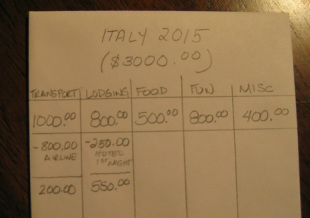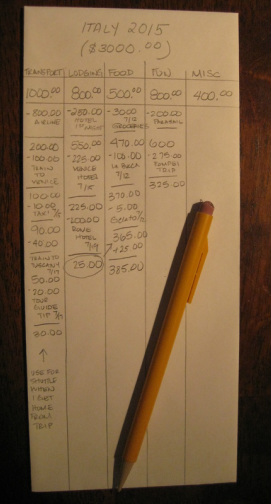
It’s true, saving for something tangible is far easier than saving just because you should or because I tell you to. Exponentially, saving for something positive that you want in your life (like a vacation) is far easier than saving for something you hope never happens (like an emergency). This is why I refuse to use the terms rainy day fund or emergency fund in my practice. Referring to your savings using these terms invites negativity into your financial subconscious. Why would you save for something you hope never happens?!? In a rational world you wouldn’t work really hard to propel towards something you don’t want, so why should you be expected to do so in your finances? Even if you don’t subscribe to the laws of attraction you can likely agree that when you are in a bad mood, bad or annoying things tend to happen and likewise when you are in a good mood, positive things tend to happen. Regardless, I guarantee that if you are only saving for emergencies, emergencies will tend to happen. It’s that Murphy and his damn laws I tell you!
Another reason I don’t refer to these savings as rainy day funds or emergency funds is that it attaches a subconscious negative stigma to this money. You may or may not have noticed this yourself, but many times when people have to dip into this account (regardless of how big or how small the balance is) is feels like you are doing something taboo. It’s almost painful, like you’ve failed in some way, shape or form. So again, why would you put money into an account where you feel guilty if you ever need to use it? Are you starting to see how we sabotage our savings before we have even started? No wonder it is so hard to save for anything other than the things you really want that you know will bring you joy. Last time I checked an emergency does not equal joy. Just sayin.
Instead, I want you to start thinking of, and calling, your savings account your FREEDOM FUND! Remember, this is a separate savings account from your periodic savings- if you need a refresher on PERIODIC SAVINGS click here. By simply renaming this account you will subconsciously shift your energy from saving for negative reasons into saving for positive reasons- things that you want to attract/invite into your life.
EXERCISE: Take a moment to write down the word FREEDOM on the top of a piece of paper. Do this by hand- numerous academic studies have found that doing exercises like these in your own handwriting reinforces the habits you are trying to create.
Maybe if you had a Freedom Fund you would:
- Be able to take a day off if you are sick/ or be able to simply take a personal day
- Look for a better job/ hold out for a better offer
- Start training/school for something you have always wanted to learn/be
- Be able to spend more time with your kids/ family/ hobbies
- Be able to live enjoy life like normal while waiting for that check to come in (Those of you who are self-employed know what I mean)
- Be able to take a vacation
Remember when we all agreed it is much easier to save for things that are both tangible and positive? These THINGS you just wrote down are the tangible reasons for starting your Freedom Fund today. I encourage my clients to tape small pictures of these items onto their credit or debit cards. When you can see these "freedoms" as material it is easier to stop yourself from purchasing things you don’t need in order to funnel more money into your Freedom Fund!
So now comes the hard question I get from clients all the time: How much should I have in my Freedom Fund?
Over the years you’ve probably heard conflicting information from many different financial websites, magazines, gurus etc. that you should have between 6-8 months of living expenses set aside. Although this is a fantastic idea, it might not be a realistic goal for your situation or it may feel like way too overwhelming of an amount to even start. The average monthly expenses in Los Angeles for those without children are about $5000-7000…that means according to the gurus you would need somewhere between $30,000- $56,000 in this account. That’s a lot of money and it can easily feel like an insurmountable goal when you can barely save anything to begin with. As a finance coach who works in the gray area and not just the black and white like said "gurus", my answer to how much you need is slightly different. Ask yourself the following questions….
- What is the longest period of time you have been unemployed? Or waited for a check?
- Knowing your own personality how much time would you give yourself before you would require yourself to make hard, life changing decisions, like selling possessions, getting a roommate, moving, or even taking a low paying job just to make ends meet?
For some of you the answer would be 3 months or even less, for some it might be 4 months, 6 months, or even a year. There’s your answer. Now, it will obviously take some work to get to your goal and it won’t happen overnight, but now you have a realistic idea of the amount of FREEDOM that this fund will buy you when/if you need it. So now that you know what the goal is for your Freedom Fund, how do you get started? Well, besides writing it down, two ways…if you need some guidance, make an appointment with me and we will sit down together to calculate out what your targeted monthly savings should be with your current income and lifestyle, or if you are ready to try on your own, just get started!
I know it sounds too simple, but it’s true! Open up a second savings account, maybe it’s an online account (these Money Market accounts usually have higher interest rates anyway- but definitely avoid any accounts with maintenance fees! Check bankrate.com for current offers) so it’s one step away from your everyday account and slightly less tempting to “borrow” from. Then, start with a small monthly auto-transfer. Maybe it’s $25 a month, maybe $50 or maybe you set it up so that every time a paycheck gets deposited a certain amount automatically gets transferred into your Freedom Fund. Likely, after a short while you won’t even miss this money anymore. SIDE NOTE: Be sure to revisit this amount and increase it whenever possible. Before you know it you will have accrued a nice little savings and I promise once you hit a certain amount (every person is different and it’s hard to say what your amount will be, but you will know it when you get there) you will start to get the same amount of pleasure out of saving and watching that total grow than you do out of spending it on things that don’t bring ultimate joy to your life! And... if you ever need to dip into it to buy yourself some freedom for any of the reasons you listed above you can do it guilt free knowing that this is what this savings account is meant to do for you!
So here’s to saving for _____ months (only you will know what your number is) of financial FREEDOM and as always if you need a helping hand or have a financial question you need answered, just call Ari!














